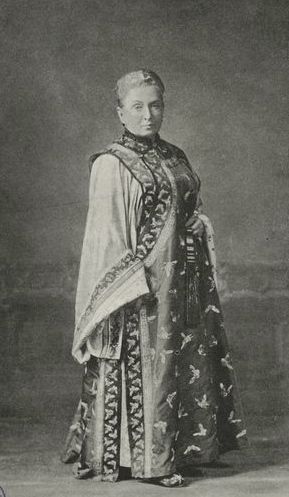Unbeaten Tracks in Japan
Isabella L. Bird
The Meiji restoration in 1868 and the following opening of a country closed to outsiders for centuries sparked an enormous worldwide interest in all things Japanese. While the average Japanophile of the time was content with exported ceramics, kimono, art, or weapons, there were a handful that were not satisfied with second-hand accounts, but visited the country by themselves.
 Isabella Lucy Bird was one of them. Already a seasoned traveller, she toured mostly the rural parts of Japan. Her trip of 1878 took her first from Tokyo to Nikko, and then all the way through the often hardly passable wilderness of the Japanese Alps to Aomori, the northernmost prefecture of Honshu. From there, she took a steamer to Yezo (Hokkaido), then a wild and untamed island inhabited by the native Ainu, a people of non-Japanese origin. Isabella travelled chiefly with man-pulled carts and on horseback, stayed at tiny local guesthouses where she – often grudgingly – had to eat the local fare, and was generally considered a major attraction for miles on end as the first white woman the local residents ever laid eyes upon.
Isabella Lucy Bird was one of them. Already a seasoned traveller, she toured mostly the rural parts of Japan. Her trip of 1878 took her first from Tokyo to Nikko, and then all the way through the often hardly passable wilderness of the Japanese Alps to Aomori, the northernmost prefecture of Honshu. From there, she took a steamer to Yezo (Hokkaido), then a wild and untamed island inhabited by the native Ainu, a people of non-Japanese origin. Isabella travelled chiefly with man-pulled carts and on horseback, stayed at tiny local guesthouses where she – often grudgingly – had to eat the local fare, and was generally considered a major attraction for miles on end as the first white woman the local residents ever laid eyes upon.
Unbeaten Tracks in Japan is composed of letters she wrote to her sister, where she faithfully describes her impressions of the landscape and the Japanese and their strange customs. As a foreigner, she is often a special guest at various ceremonies or of high-ranking people, and especially her account of the Ainu and their long-lost customs holds many surprises even for modern Japanese.
I greatly enjoyed this book, it gives a glimpse into a Japan long forgotten, although some things still appear familiar. However, her writings are not at all politically correct, and she certainly never sugarcoats her opinions. She generally loves the countryside and is charmed by the children everywhere, but she despises the Japanese food she had to eat once her own provisions ran out, and she also views the Japanese adults unfavourably – she describes them as ugly, uncouth, and dirty, the last most likely because of their extreme poverty. Anyway, if you can see beyond her old-fashioned, almost missionary attitudes, the book is a great source for those interested in the really “old” Japan.
Fun fact: Although more than 100 years old, this book has been translated to Japanese less than five years ago.
The book is available from amazon of course, but there is also a free e-book available from gutenberg.org, and, based on it, a free audio version from librivox.org.

I didn’t know Bird’s travel books hadn’t been available in Japanese for such a long time! I finished the second volume two months or so back. I was really impressed by it – by the details, her description, the mode of travel. I was also amazed seeing places I had visited through her eyes and noticing how little has changed in the time in between in many cases. I’ve also read the books by Alan Booth, a more recent traveller, but I found that they, too, in their way, opened up a new perspective on Japan. I got interested in travel accounts through my interest in Japan and I keep looking for new ones :).
My favourite part of that book was probably the one where she was riding the cow… 🙂
Alan Booth is great, his humour is very contagious, even though I don’t think I would ever want to walk through Japan like he did… I have read both of his books, there will be a post about them in the future.
If you’re into travelogues, try Jinrikisha Days in Japan by Eliza Scidmore (still on my reading list). She was a contemporary of Isabella’s and was visiting Japan several times, also right after the Meiji restauration – and she is single-handedly responsible for the cherry trees in West Potomac Park in Washington!